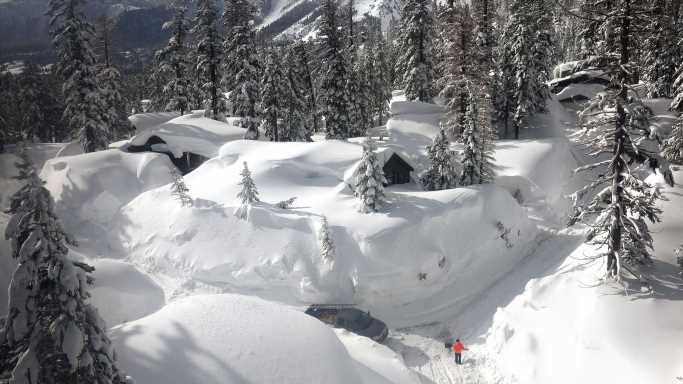With California’s mountains buried under a historically deep snowpack and more storms on the way, the latest drought outlook from NOAA shows continuing improvement in the state’s drought situation.
The big picture: California has long experienced sudden swings between drought and flood, but the rapid fire assault by about a dozen atmospheric river storm events since December is on the extreme end of weather whiplash.
Driving the news: The Drought Monitor shows no coverage of the top two most severe categories of drought, “exceptional” and “extreme,” eliminating them from the state’s drought map for the first time since 2020, NOAA stated Thursday.
- Statewide, the snowpack stood at 223% of average for March 16, and could break the seasonal record on April 1. This is typically the seasonal peak for the state’s snow cover.
- When this snowpack melts, it will pose flooding dangers, particularly if any mild Pacific storms affect the higher elevations with rainfall, or spring heat waves occur.
Zoom in: The drought shift is striking — as of March 14, 36% of California was in some category of drought conditions, compared to 99.7% at the start of the water year on Oct. 1.
- At the start of the water year, 40.9% of the state was classified as being in the two worst drought categories. Today that figure is down to 0%.
- The snowpack is so thick it has forced several ski areas to close in order to dig out their ski lifts.
The water supply picture in California is drastically improved for the upcoming dry season compared to the past few years. Compared to this time last year, the water levels in Shasta Lake and Lake Oroville are up by about 80%.
- Reflecting this improvement, the Metropolitan Water District of Southern California announced Wednesday it would end emergency water restrictions for about 7 million people.
Yes, but: The improvements in the California drought as measured by the snowpack and Drought Monitor statistics do not mean the Southwestern megadrought, which began in 2000, has ended.
- It will take more wet winters to replenish groundwater supplies depleted by farmers, ranchers and other water users in California and surface drought has not fully relented in neighboring states.
Context: Research published this week provides observational evidence for worsening water extremes, both heavy precipitation and drought conditions, around the world due to the effects of human-caused climate change.
- Other studies have shown that climate change is causing atmospheric rivers to carry more water vapor, and for the movement from wet to dry extremes to become more pronounced and frequent.
What we’re watching: The pace of the snow melt in California. Any heat waves or mild storms that bring rains into high elevations could cause serious flooding concerns with reservoirs already filling up and major rivers elevated.
- With homes entombed in snow throughout the Sierras, structural failures could also arise as the snow melts.
Source: Read Full Article
-
Penny Mordaunt flouted No. 10 ban to meet boycotted group MCB
-
I look 14 and no one can guess my real age – I have to carry my birth certificate at all times | The Sun
-
Wife of Russian defence official was on holiday as bombs fell on Kyiv
-
AI can now forecast the next food crisis
-
Ex-Catholic priest Timothy Evans sued over alleged sexual assault

